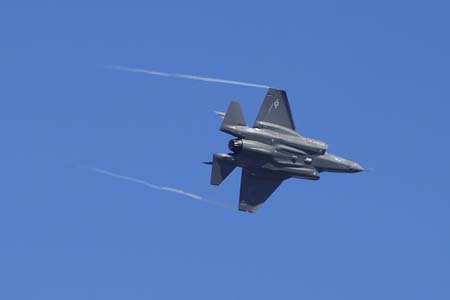On Thur sday afternoon, when the full House passed the 2010 defense policy bill (HR 2647), it not only included more F-22s but also direction to the Air Force to report on how it plans to address the fighter gap, which lawmakers believe has been exacerbated by USAF’s plan to retire 254 legacy fighters next year. The House wants USAF to consult with its reserve components to provide “their independent views to Congress,” and specifically with the Air Guard to address the projected air sovereignty alert shortfall. The report, which is due March 1, 2010, is to provide short- and long-term solutions, covering at least three alternatives: accelerated fifth-generation (F-22 and F-35) fighter procurement; interim procurement of 4.5 generation fighters; and service life extension programs for existing fighters. The House also wants the Air Force to directly address the prospective loss of ANG flying missions around the country and the resultant loss of pilots and skilled maintainers. Rep. Gabrielle Gifford (D-Ariz.) decried the Pentagon’s plan to use the Quadrennial Defense Review “as a mechanism for reducing the size of the fighter force.” She believes the service “has dismissed out of hand the only clear solution”—purchase of 4.5 gen aircraft. Rep. Frank LoBiondo (R-N.J.), who sponsored the fighter gap legislation, took the matter close to home, saying in a June 25 statement, “The fighter gap threatens the long-term viability of the 177th Fighter Wing specifically and the security of South Jersey and the region.” And, earlier during a hearing, he commented, “Once the planes go away, the mission goes away; once the mission goes away, the people with their experience and technical experience go away.”
sday afternoon, when the full House passed the 2010 defense policy bill (HR 2647), it not only included more F-22s but also direction to the Air Force to report on how it plans to address the fighter gap, which lawmakers believe has been exacerbated by USAF’s plan to retire 254 legacy fighters next year. The House wants USAF to consult with its reserve components to provide “their independent views to Congress,” and specifically with the Air Guard to address the projected air sovereignty alert shortfall. The report, which is due March 1, 2010, is to provide short- and long-term solutions, covering at least three alternatives: accelerated fifth-generation (F-22 and F-35) fighter procurement; interim procurement of 4.5 generation fighters; and service life extension programs for existing fighters. The House also wants the Air Force to directly address the prospective loss of ANG flying missions around the country and the resultant loss of pilots and skilled maintainers. Rep. Gabrielle Gifford (D-Ariz.) decried the Pentagon’s plan to use the Quadrennial Defense Review “as a mechanism for reducing the size of the fighter force.” She believes the service “has dismissed out of hand the only clear solution”—purchase of 4.5 gen aircraft. Rep. Frank LoBiondo (R-N.J.), who sponsored the fighter gap legislation, took the matter close to home, saying in a June 25 statement, “The fighter gap threatens the long-term viability of the 177th Fighter Wing specifically and the security of South Jersey and the region.” And, earlier during a hearing, he commented, “Once the planes go away, the mission goes away; once the mission goes away, the people with their experience and technical experience go away.”
The Air Force is requesting about $141 million for initial enlistment bonuses in its fiscal 2026 budget, while Space Force wants $13 million.
